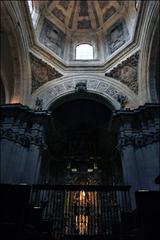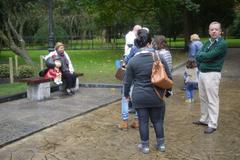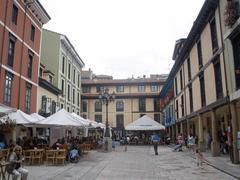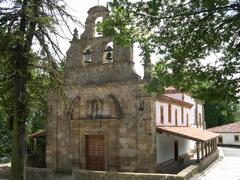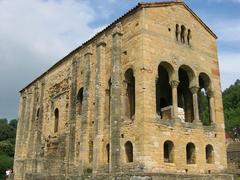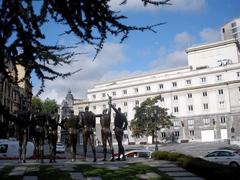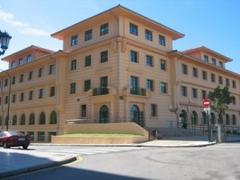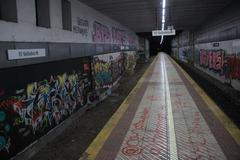
Palacio Episcopal de Oviedo: Visiting Hours, Tickets, and Complete Travel Guide
Date: 03/07/2025
Introduction: Discover the Palacio Episcopal de Oviedo
Nestled in the heart of Oviedo, Spain, the Palacio Episcopal de Oviedo stands as a monumental testament to Asturias’ religious, cultural, and civic legacy. Adjacent to the Cathedral of San Salvador, this palace has been the residence of the Bishop of Oviedo since the early 9th century, reflecting its vital role in the region’s ecclesiastical history. Its architectural grandeur, featuring Romanesque, Gothic, Renaissance, and Baroque elements, offers a visual journey through centuries of Asturian history.
For pilgrims on the Camino de Santiago, the palace’s proximity to the cathedral and the Cámara Santa (Holy Chamber) underscores Oviedo’s importance on this legendary route. The palace continues to host religious ceremonies and civic events, remaining a vibrant center of community and spiritual life.
This comprehensive guide covers everything you need to plan your visit: historical context, visiting hours, ticketing, accessibility, guided tours, nearby attractions, and practical tips to enhance your experience (Omnesmag, Vivir Asturias, Turismo Asturias).
Table of Contents
- Introduction
- History and Architectural Evolution
- Religious, Cultural, and Civic Significance
- Visiting Hours, Tickets, and Accessibility
- Guided Tours and Special Events
- Travel Tips: Getting There and Best Times to Visit
- Nearby Attractions and Photo Opportunities
- Practical Visitor Information
- Frequently Asked Questions (FAQ)
- Conclusion and Visitor Tips
- Sources and Further Reading
History and Architectural Evolution
Origins and Early Development
The Palacio Episcopal traces its origins to the early 9th century, when King Alfonso II the Chaste founded the Diocese of Oviedo and established the bishop’s residence adjacent to the newly built cathedral (Omnesmag). Though little remains of the original structure, the palace’s enduring presence in Plaza de Alfonso II el Casto marks its central role in the Asturian church (whc.unesco.org).
Medieval and Renaissance Transformations
Throughout the Middle Ages, the palace expanded to accommodate growing ecclesiastical duties and the influx of pilgrims. The devastating fire of 1522 destroyed much of Oviedo’s historic center, leading to a significant reconstruction of the palace in the late 16th century under Bishop Diego Aponte de Quiñones. This phase introduced classicist symmetry and restrained decoration (Vivir Asturias).
Baroque Enhancements and Modern Restorations
In the 18th century, the Baroque Tránsito de Santa Bárbara was added, connecting the palace to the cathedral. The building suffered damage during the 20th-century conflicts, but thorough restoration efforts have preserved its historic character (Guias de Ruta).
Architectural and Artistic Features
The palace integrates Romanesque, Gothic, Renaissance, and Baroque styles. Highlights include the main façade with rusticated entrance, ornate wrought-iron balconies, a Tuscan-style porticoed courtyard, and the private episcopal chapel. Heraldic shields and period furnishings narrate the legacy of successive bishops (Minube).
Religious, Cultural, and Civic Significance
Ecclesiastical Authority and Pilgrimage
The Palacio Episcopal has long symbolized ecclesiastical authority in Asturias. Its close connection with the Cathedral of San Salvador and the Cámara Santa has made it a focal point for pilgrims on the Camino de Santiago, reinforcing Oviedo’s status as a spiritual waypoint (Turismo Asturias).
Liturgical and Ceremonial Life
Major liturgical events such as ordinations, processions, and diocesan synods are often held in the palace. During Holy Week and the Fiesta de San Mateo (September), the bishop leads public ceremonies, reinforcing the palace’s living role in Oviedo’s religious calendar (Omnesmag).
Cultural Engagement and Civic Functions
Beyond its religious role, the palace hosts academic, cultural, and civic gatherings, and supports local heritage initiatives. It has played a key role in promoting the Asturian language and literature and participates in community outreach and charitable activities (portalpueblos.com).
Visiting Hours, Tickets, and Accessibility
- Visiting Hours: The palace is typically closed to daily visitors but opens for guided tours and during special events (e.g., Holy Week, Fiesta de San Mateo, European Heritage Days). Check the Oviedo Tourism Office or the Cathedral’s official website for up-to-date schedules.
- Tickets: Viewing the exterior is always free. Interior access, when available, may require advance booking—some guided tours are free, others may charge a small fee.
- Accessibility: The plaza is wheelchair accessible, but some interior areas have limited access due to historic architecture. Contact the administration in advance to arrange specific assistance (Turismo Asturias).
Guided Tours and Special Events
Guided tours provide insight into the palace’s art, history, and religious functions. Tours are usually in Spanish, with occasional English-language options during peak seasons. Special events and exhibitions are held throughout the year—check local listings and official sites for updates (Vivir Asturias).
Travel Tips: Getting There and Best Times to Visit
- Location: Plaza de Alfonso II el Casto, s/n, 33003 Oviedo, Asturias, Spain.
- Transport: Oviedo’s historic center is pedestrian-friendly. The palace is within walking distance of the main train/bus stations and close to public parking garages (thebestplacesinspain.blogspot.com).
- Best Times to Visit: Spring and early autumn offer mild weather and fewer crowds. Festivals such as San Mateo in September provide a unique cultural experience.
Nearby Attractions and Photo Opportunities
- Cathedral of San Salvador: Gothic masterpiece with the UNESCO-listed Cámara Santa.
- Archaeological Museum of Asturias: Housed in a former monastery, showcasing regional history.
- Plaza del Fontán: Lively square with a traditional market and cafés.
- San Francisco Park: Oviedo’s largest green space, ideal for relaxation.
- Photo Tips: The palace’s main façade and the Tránsito de Santa Bárbara are particularly photogenic, especially during golden hour (thetraveltester.com).
Practical Visitor Information
- Language: Spanish predominates; basic knowledge is helpful.
- Currency: Euro (€); credit cards are widely accepted.
- Dress Code: Modest attire is recommended, especially when attending religious sites.
- Food & Drink: Try local specialities such as fabada asturiana and Asturian cider at nearby sidrerías. Don’t miss Carbayones pastries from local bakeries (audiala.com).
- Accommodation: Options range from luxury (Hotel de la Reconquista) to modern (Ayre Hotel Oviedo) and cozy central hotels (thetraveltester.com).
Frequently Asked Questions (FAQ)
Q: Is there an entrance fee to visit the Palacio Episcopal de Oviedo?
A: No fee for viewing the exterior. Interior visits during special events may require ticket reservation; some tours may have a small fee.
Q: When can I visit the palace interior?
A: Only during special cultural events or guided tours, such as European Heritage Days or local festivals.
Q: Are guided tours available?
A: Yes, but only during specific events. Check with the Oviedo Tourism Office for current options.
Q: Is the palace accessible for visitors with disabilities?
A: The square is generally accessible, but the palace interior may have limitations. Contact the administration for details.
Q: How do I get there by public transport?
A: The palace is in the pedestrianized city center, accessible by bus, taxi, or a short walk from public parking or transport hubs.
Conclusion and Visitor Tips
The Palacio Episcopal de Oviedo is not just an architectural gem but a living symbol of Asturias’ religious and civic history. Whether you’re drawn by its architectural beauty, historical resonance, or its vibrant role in local traditions, the palace makes an essential stop on any Oviedo itinerary. While interior visits are limited, the palace’s striking façade, central location, and proximity to other major landmarks ensure a rewarding experience for all visitors.
Tips for your visit:
- Plan your trip during festivals or special events for potential interior access.
- Allow time to explore nearby attractions and sample local cuisine.
- Download the Audiala app for the latest updates, digital guides, and insider tips.
Sources and Further Reading
- Omnesmag: The 1,200 Years of the Cathedral of Oviedo
- Vivir Asturias: Palacio Arzobispal
- Turismo Asturias: Top Things to See and Do in Oviedo
- The Best Places in Spain: What to Visit in Oviedo City
- La Nueva España: Pre-Romanesque Walls Discovered
- El Tesoro de Oviedo: Palacio Episcopal
- Minube: Palacio Episcopal
- Guias de Ruta: Palacio Episcopal
- The Travel Tester: What to Do in Oviedo
- Audiala: Oviedo City Guide
- Best Time to Visit Oviedo






